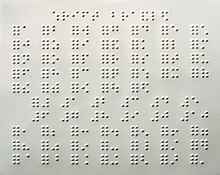Tajik Braille
| Russian Braille |
|
|---|---|
 |
|
| Type |
alphabet
|
| Languages | Russian |
|
Parent systems
|
Braille
|
|
Print basis
|
Russian alphabet |
Russian Braille is the braille alphabet of the Russian language. With suitable extensions, it is used for languages of neighboring countries that are written in Cyrillic in print, such as Ukrainian and Mongolian. It is based on the Latin transliteration of Cyrillic, with additional letters assigned idiosyncratically. In Russian, it is known as Шрифт Брайля Shrift Braylya 'Braille Script'.
The Russian Braille alphabet is as follows:
The adaptation of ⠟ q to ч [tɕ] and ⠭ x to щ [ɕː] is reminiscent of the adaptation in Chinese pinyin of q to [tɕ] and x to [ɕ].
Contractions are not used.
The pre-Revolutionary alphabet, reproduced at right from an old encyclopedia, includes several letters which have since been dropped. In addition, the letter э is shown with a slightly different form.
Although obsolete in Russian Braille, these letters continue in several derivative alphabets.
Single punctuation:
Paired punctuation:
Columns marked with ⠿ are shown in the braille-chart image in the box, above right.
Numbers are the letters a–j introduced with ⠼, as in other alphabets. Arithmetical symbols are as follows. The lowered g used for parentheses in prose becomes an equal sign in arithmetic, where a symmetrical pair of parentheses is used instead:
Arithmetical symbols are preceded but not followed by a space, with the exception of the multiplication dot. For example:
In print, many languages of the ex–Soviet Union are written in Cyrillic alphabets derived from the Russian alphabet by adding new letters. Their braille alphabets are similarly derived from Russian Braille. The braille assignments for the letters found in Russian print are the same as in Russian Braille. However, there is no international consistency among the additional letters, apart from ⠽ і, which is used in Ukrainian, Belarusian, and Kazakh – and even then, Kyrgyz uses ⠽ for ң (ŋ), and it might be that Tajik uses it for қ (q). Generally not all of the Russian letters are used, except perhaps in Russian loans. Punctuation and formatting, as far as they are attested, agree with Russian Braille, though Kazakh Braille is reported to use the Russian arithmetical parentheses ⠣⠀⠜.
...
Wikipedia
